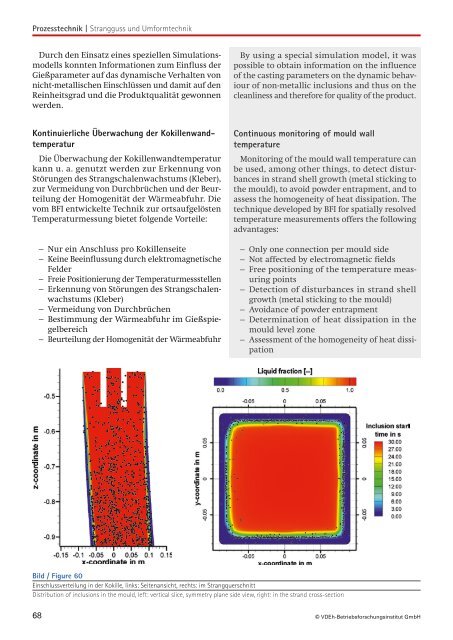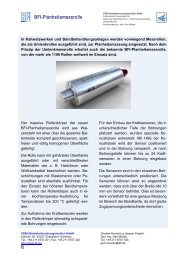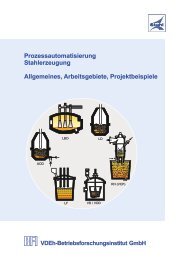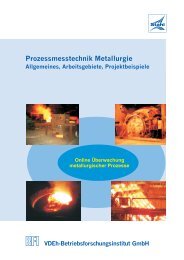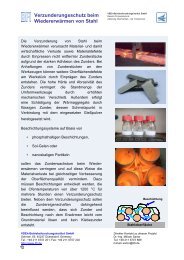Tätigkeitsbericht /Activity Report 2011/2012 - BFI.de
Tätigkeitsbericht /Activity Report 2011/2012 - BFI.de
Tätigkeitsbericht /Activity Report 2011/2012 - BFI.de
Erfolgreiche ePaper selbst erstellen
Machen Sie aus Ihren PDF Publikationen ein blätterbares Flipbook mit unserer einzigartigen Google optimierten e-Paper Software.
Prozesstechnik | Strangguss und Umformtechnik<br />
Durch <strong>de</strong>n Einsatz eines speziellen Simulationsmo<strong>de</strong>lls<br />
konnten Informationen zum Einfluss <strong>de</strong>r<br />
Gießparameter auf das dynamische Verhalten von<br />
nicht-metallischen Einschlüssen und damit auf <strong>de</strong>n<br />
Reinheitsgrad und die Produktqualität gewonnen<br />
wer<strong>de</strong>n.<br />
By using a special simulation mo<strong>de</strong>l, it was<br />
possible to obtain information on the influence<br />
of the casting parameters on the dynamic behaviour<br />
of non-metallic inclusions and thus on the<br />
cleanliness and therefore for quality of the product.<br />
Kontinuierliche Überwachung <strong>de</strong>r Kokillenwandtemperatur<br />
Die Überwachung <strong>de</strong>r Kokillenwandtemperatur<br />
kann u. a. genutzt wer<strong>de</strong>n zur Erkennung von<br />
Störungen <strong>de</strong>s Strangschalenwachstums (Kleber),<br />
zur Vermeidung von Durchbrüchen und <strong>de</strong>r Beurteilung<br />
<strong>de</strong>r Homogenität <strong>de</strong>r Wärmeabfuhr. Die<br />
vom <strong>BFI</strong> entwickelte Technik zur ortsaufgelösten<br />
Temperaturmessung bietet folgen<strong>de</strong> Vorteile:<br />
– Nur ein Anschluss pro Kokillenseite<br />
– Keine Beeinflussung durch elektromagnetische<br />
Fel<strong>de</strong>r<br />
– Freie Positionierung <strong>de</strong>r Temperaturmessstellen<br />
– Erkennung von Störungen <strong>de</strong>s Strangschalenwachstums<br />
(Kleber)<br />
– Vermeidung von Durchbrüchen<br />
– Bestimmung <strong>de</strong>r Wärmeabfuhr im Gießspiegelbereich<br />
– Beurteilung <strong>de</strong>r Homogenität <strong>de</strong>r Wärmeabfuhr<br />
Continuous monitoring of mould wall<br />
temperature<br />
Monitoring of the mould wall temperature can<br />
be used, among other things, to <strong>de</strong>tect disturbances<br />
in strand shell growth (metal sticking to<br />
the mould), to avoid pow<strong>de</strong>r entrapment, and to<br />
assess the homogeneity of heat dissipation. The<br />
technique <strong>de</strong>veloped by <strong>BFI</strong> for spatially resolved<br />
temperature measurements offers the following<br />
advantages:<br />
– Only one connection per mould si<strong>de</strong><br />
– Not affected by electromagnetic fields<br />
– Free positioning of the temperature measuring<br />
points<br />
– Detection of disturbances in strand shell<br />
growth (metal sticking to the mould)<br />
– Avoidance of pow<strong>de</strong>r entrapment<br />
– Determination of heat dissipation in the<br />
mould level zone<br />
– Assessment of the homogeneity of heat dissipation<br />
Bild / Figure 60<br />
Einschlussverteilung in <strong>de</strong>r Kokille, links: Seitenansicht, rechts: im Strangquerschnitt<br />
Distribution of inclusions in the mould, left: vertical slice, symmetry plane si<strong>de</strong> view, right: in the strand cross-section<br />
68 © VDEh-Betriebsforschungsinstitut GmbH


